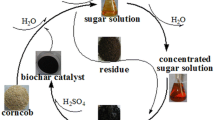Abstract
This work aims to study the immobilization of Candida rugosa lipase (CRL) onto corn straw residue. For this purpose, chemical, morphological, and textural characteristics of the corn straw; immobilization process by adsorption; and immobilized enzyme activity and storage stability were evaluated. The corn straw presented isoelectric point of 7.0, surface with hydroxyl bands being favorable to the immobilization process. An irregular surface was also observed with fibers and pores, which are mesoporous and macroporous, characteristics that demonstrate efficiency in mass transfer mechanisms. Upon immobilization, it was observed that adsorption velocity is proportional to the square of the available adsorption sites (pseudo-second-order), and that the immobilization occurs in monolayers (Langmuir isotherm). The adsorption process was favorable and considered as a chemical adsorption mechanism. After immobilization, the optimum temperature increased, the optimum pH reduced, and the affinity of the biocatalyst for the substrate decreased. Corn straw derivative demonstrated good thermal stability. Regarding storage stability, there was approximately 12% loss of activity after 60 days of storage at 4 °C. Considering that no treatment was applied to the corn straw, this result is satisfactory and shows good affinity between this support and CRL.







Similar content being viewed by others
References
Aarathy, M., Saravanan, P., Gowthaman, M. K., Rose, C., & Kamini, N. R. (2014). Enzymatic transesterification for production of biodiesel using yeast lipases: An overview. Chemical Engineering Research and Design, 92(8), 1591–1601.
Katchalski-Katzir, E., & Kraemer, D. M. (2000). Eupergit® C, a carrier for immobilization of enzymes of industrial potential. Journal of Molecular Catalysis B: Enzymatic, 10(1-3), 157–176.
Reguly, J. C. (2000). Biotecnologia dos Processos Fermentativos (1st ed.). Recife: Universitário.
Mendes, A. A., Giordano, R. C., Giordano, R. L. C., & Castro, H. F. (2011). Immobilization and stabilization of microbial lipases by multipoint covalent attachment on aldehyde-resin affinity: Application of the biocatalysts in biodiesel synthesis. Journal of Molecular Catalysis B: Enzymatic, 68(1), 109–115.
Costa-Silva, T. A., Carvalho, A. K. F., Souza, C. R. F., De Castro, H. F., Said, S., & Oliveira, W. P. (2016). Enzymatic Synthesis of Biodiesel Using Immobilized Lipase on a Non-commercial Support. Energy & Fuels, 30(6), 4820–4824.
Lv, J., Liu, X., Yuan, X., Deng, Y., Wu, Z., Wang, Y., Fan, M., & Xu, H. (2013). Preparation and properties of adsorption material from corn stalks core when used for enzyme immobilization and the subsequent activities of the adsorbed enzymes. Industrial Crops and Products, 50, 787–796.
Regalbuto, J. R., & Robles, J. (2004). Final report - Summer Program. Chicago: University of Illinois.
Bradford, M. M. (1976). A rapid and sensitive method for the quantitation of microgram quantities of protein utilizing the principle of protein-dye binding. Analytical Biochemistry, 72(1-2), 248–254.
Yener, J., Kopac, T., Dogu, G., & Dogu, T. (2006). Adsorption of Basic Yellow 28 from aqueous solutions with clinoptilolite and amberlite. Journal of Colloid and Interface Science, 294(2), 255–264.
Blanchard, G., Maunaye, M., & Martim, G. (1984). Removal of heavy metals from waters by means of natural zeolites. Water Research, 18(12), 1501–1507.
Langmuir, I. (1916). Journal of the American Chemical Society, 252, 2221–2295.
Freundlich, H. (1909). Kolloid-Zeitschrift (Vol. 3, pp. 212–220).
HAN, R., Zhang, J., Zou, W., Shi, J., & Liu, H. (2005). Equilibrium biosorption isotherm for lead ion on chaff. Journal of Hazardous Materials, 125(1-3), 266–271.
Bon, E. P. S., Ferrara, M. A., & Corvo, M. L. (2008). Enzimas em biotecnologia: produção, aplicações e mercado (1st ed.). Rio de Janeiro: Interciência.
Soares, C. M. F., De Castro, H. F., De Moraes, F. F., & Zanin, G. M. (1999). Biotechnology and Applied Biochemistry, 77, 745–757.
Milhomem, K. P. (2018). Ms thesis. Catalão: Universidade Federal de Goiás.
Zivkovic, L. T. I., Zivkovic, L. S., Babic, B. M., Kokunesoski, M. J., Jokic, B. M., & Karadzic, I. M. (2015). Immobilization of Candida rugosa lipase by adsorption onto biosafe meso/macroporous silica and zirconia. Biochemical Engineering Journal, 93, 73–83.
Pavia, D. L., Lampman, G. M., Kriz, G. S., & Vyvyan, J. R. (2010). Introdução à espectroscopia (2nd ed.). São Paulo: Cengage Learning.
Wen, J. L., Sun, Z. J., Sun, Y. C., Sun, S. N., Xu, F., & Sun, R. C. (2010). Structural Characterization of Alkali-Extractable Lignin Fractions from Bamboo. Journal of Biobased Materials and Bioenergy, 4(4), 408–425.
IUPAC. (1976). Pure and Applied Chemistry, 46, 71–90.
Schmal, M. (2011). Cinética e reatores: aplicação na Engenharia Química (1st ed.). Rio de Janeiro: Synergia.
Maron, S. H., & Prutton, C. F. (2005). Fundamentos de Fisico-química (1st ed.). México: Limusa.
Castellan, G. W. (1986). Fundamentos de físico-química, 1st ed. Rio de Janeiro: LTC.
Fogler, H. S. (2009). Elementos de engenharia das reações químicas (4th ed.). Rio de Janeiro: LTC.
Acknowledgments
The authors are grateful to UFPR-Palotina for the surface and pore size analyses.
Funding
This paper was financially supported by CAPES.
Author information
Authors and Affiliations
Corresponding author
Ethics declarations
There is no research involving human participants and/or animals.
Conflict of Interest
The authors declare that they have no conflict of interest.
Additional information
Publisher’s Note
Springer Nature remains neutral with regard to jurisdictional claims in published maps and institutional affiliations.
Rights and permissions
About this article
Cite this article
Ferreira, R.D.M., Brackmann, R., Pereira, E.B. et al. Corn Straw Residue: a Strategy for Lipase Immobilization. Appl Biochem Biotechnol 190, 839–850 (2020). https://doi.org/10.1007/s12010-019-03132-9
Received:
Accepted:
Published:
Issue Date:
DOI: https://doi.org/10.1007/s12010-019-03132-9




